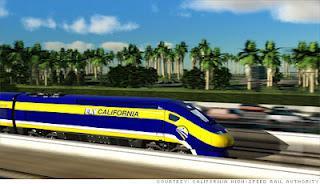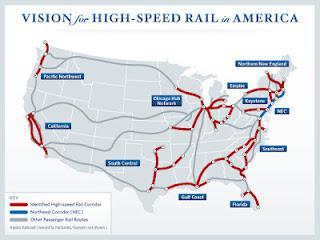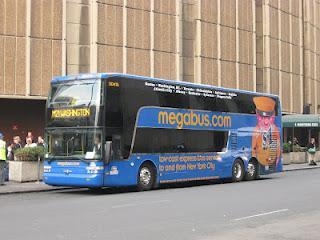
Rendering of a "future" high-speed rail train in California
Sometimesexciting ideas are bad. Take the title quote, which I read in a recent Bloomberg article by Edward Glaeser the accomplished Harvard economist [1].These four words, according to Glaeser, sum up the accepted wisdom gleaned from40 years of transportation economics at Harvard. And they are directly at oddswith one of the long-held – and long out-of-reach – goals of many Americantransportation planners: true high-speed rail (HSR in planning and transitlingo).High Speed Rail in America
Formany decades (if not longer) there has been a desire among transit advocates toconnect America’s cities with a web of efficient, clean, fast trains. Thistransit mode would act as an environmentally friendly alternative to theautomobiles that crowd urban highways and dirty the air, and to expensive, pollutingplanes. Advocates point to the successful HSR systems in Western Europe andJapan [2] andmodels for a future American system. Indeed, HSR does offer advantages overother transportation modes, but only under the right conditions. Thoseconditions include densely populated areas along the train route, relativelyunderdeveloped highway infrastructure, high gas prices, existing heavy passengerrail use, and relatively short distances. These conditions are needed becauseHSR becomes economically feasible when ridership is high. And ridership willonly be high if it’s more cost effective for people to use HSR than it is touse other modes, or borrowing terms from economics, if the combination of cost(the price of a ticket) and duration (the time the trip takes) are lower thancompeting modes (road and air).
InJapan, where there are 65 million people living tightly along the 250 milecorridor between Tokyo and Osaka, HSR is an ideal solution. Similarly, thedensely packed corridor in France between Paris and Lyon is a prime location.In Japan and France gas prices and population densities are high, intercityfreeways are less extensive, and major urban areas are closely spaced. And evenin these locations, HSR like other transit modes isn’t self-supporting. It requiresgovernment investment to fund the capital expense and support the highoperating costs [3].This investment is justified because of the high value of time saved by movingso many riders.
Ifyou look at the United States, the conditions for HSR are far less favorable.Gas is cheap [4],the interstate highway system is vast, and excepting the Northeast Corridorbetween Washington and Boston [5], population centers are widely spacedacross the continent. Today, on a national level, only about one half of onepercent of passenger trips are made by train of any sort and just one tenth ofone percent are taken on intercity rail. The Northeast Corridor is the mostheavily used intercity passenger train route, but Amtrak’s semi-high-speedAcela train [6]deployed on that route only accounts for about three million trips annually. Anumber dwarfed by automobile trips on Interstate 95, the parallel freeway.

Andthere has been a backlash against HSR in the last couple of years. InCalifornia more than two-thirds of the public is now against the state’s HSRplan. Florida, Wisconsin, and Ohio, refused to accept federal money to even studyHSR. Turning back money seems like a remarkable thing for any government to do,and it speaks to how much skepticism there is for the viability of HSR inAmerica. A fear of the white elephant that many pay for and few use. Hopefully otherstates will follow this trend and avoid force-feeding HSR to an unreceptivepublic, sinking billions of dollars of federal and state funding into what isultimately for most of America, a bad idea.
An Easily and Successful Alternative
Sometimesboring ideas are good. Despite the conditions being poor for HSR, there is agrowing need for alternative transportation choices to go from one city toanother. Rising gas prices make automobile and airplane trips more expensive.Congestion and tolls add time and cost to highway trips. These circumstanceshave led to one of the great, if unexciting, recent success stories in Americantransportation: the growth of intercity buses.

Busesare good for passengers, but also for everyone else. Buses are more efficientand better for the environment than cars. They reduce congestion by putting alot of people in one vehicle and commensurately reducing the number of cars onthe road. And by reducing the number of cars, the total volume of pollutants isalso reduced.
Thissuccess is particularly appealing to me because it’s happening largely withoutgovernment support, based on private initiative and competition. It’s aprofitable, sustainable, user-pays approach; exactly the type of solution U.S.transportation policy should support. The market is still developing, butintercity bus is a promising, realistic alternative to HSR. In the years tocome routes will no doubt proliferate across most of the country. In this case,Harvard wisdom may be right, “bus good, train bad.”
---
NOTES:
[1]And author of the 2011 book, The Triumphof the City, a very good, informative read, which I recommendhighly.
[2] Whichinclude thousands of miles of track in China, Japan, France, and Spain, andhundreds of miles in Germany, Italy, Russia, Turkey, South Korea, Taiwan, andBelgium.
[3]The French HSR lines were built and are operated by the government. JapaneseHSR trains were built by the government but are now operated by a privateconsortium.
[4]Certainly when compared to fuel prices in Japan or Western Europe.
[5]The Northeast Corridor connects Washington, Baltimore, Philadelphia, New York,and Boston, along with several other medium sized cities in between. Using 2008data, the five large Northeast Corridor cities are among the eight highestAmerican cities in overall transit use.
[6]Amtrak’s Acela train is capable of speeds of 150 mph, but the existing trackand power infrastructure, along with the sharing of tracks with other trains,result in average speeds well under 100 mph.
[7]These include Megabus, Boltbus, Trailways, Red Coach, and DC2NY Bus, to name afew.

